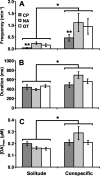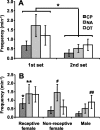Frequency of dopamine concentration transients increases in dorsal and ventral striatum of male rats during introduction of conspecifics
- PMID: 12451147
- PMCID: PMC6758730
- DOI: 10.1523/JNEUROSCI.22-23-10477.2002
Frequency of dopamine concentration transients increases in dorsal and ventral striatum of male rats during introduction of conspecifics
Abstract
Transient, elevated concentrations of extracellular dopamine were characterized in the dorsal and ventral striatum of male rats during solitude, brief interaction with a conspecific, and copulation. Conspecific rats were systematically presented to male rats and allowed to interact for 30 sec; the males were kept in solitude between each presentation. During these episodes, 125 dopamine concentration transients from 17 rats were detected with fast-scan cyclic voltammetry at carbon-fiber microelectrodes (peak amplitude, 210 +/- 10 nm; duration, 530 +/- 20 msec). The frequency of dopamine transients increased sixfold during conspecific episodes compared with solitude. However, the phasic dopamine activity habituated on the second presentation of the conspecifics. When males were allowed to copulate with receptive females, additional dopamine transients were observed at frequencies approximately 20% of those during the previous interaction episodes. A subset of these transients immediately preceded intromission. Overall, phasic dopamine activity appeared to be associated with input from multiple sensory modalities and was followed by a variety of approach and appetitive behaviors, consistent with electrophysiological observations of dopaminergic neuron burst-firing. In summary, (1) dopamine concentration transients occur in awake rats during solitude, in the absence of overt external cues; (2) dopamine transients are significantly more frequent in the presence of a conspecific, although this effect habituates; and (3) dopamine transients are less frequent during copulation than during brief conspecific episodes. These results establish for the first time that transient dopamine fluctuations occur throughout the dorsal and ventral striatum and demonstrate that they are more frequent with salient stimuli that elicit a response behavior.
Figures








Similar articles
-
Nomifensine amplifies subsecond dopamine signals in the ventral striatum of freely-moving rats.J Neurochem. 2004 Aug;90(4):894-903. doi: 10.1111/j.1471-4159.2004.02559.x. J Neurochem. 2004. PMID: 15287895
-
Amphetamine paradoxically augments exocytotic dopamine release and phasic dopamine signals.J Neurosci. 2013 Jan 9;33(2):452-63. doi: 10.1523/JNEUROSCI.2136-12.2013. J Neurosci. 2013. PMID: 23303926 Free PMC article.
-
Real-time measurement of electrically evoked extracellular dopamine in the striatum of freely moving rats.J Neurochem. 1997 Jan;68(1):152-61. doi: 10.1046/j.1471-4159.1997.68010152.x. J Neurochem. 1997. PMID: 8978721
-
Transient changes in mesolimbic dopamine and their association with 'reward'.J Neurochem. 2002 Aug;82(4):721-35. doi: 10.1046/j.1471-4159.2002.01005.x. J Neurochem. 2002. PMID: 12358778 Review.
-
Detecting subsecond dopamine release with fast-scan cyclic voltammetry in vivo.Clin Chem. 2003 Oct;49(10):1763-73. doi: 10.1373/49.10.1763. Clin Chem. 2003. PMID: 14500617 Review.
Cited by
-
Deconstructing the contribution of sensory cues in social approach.Eur J Neurosci. 2021 May;53(9):3199-3211. doi: 10.1111/ejn.15179. Epub 2021 Mar 24. Eur J Neurosci. 2021. PMID: 33751673 Free PMC article.
-
Endocannabinoids Interact With the Dopaminergic System to Increase Sexual Motivation: Lessons From the Sexual Satiety Phenomenon.Front Behav Neurosci. 2019 Aug 14;13:184. doi: 10.3389/fnbeh.2019.00184. eCollection 2019. Front Behav Neurosci. 2019. PMID: 31474840 Free PMC article.
-
Dynamic gain control of dopamine delivery in freely moving animals.J Neurosci. 2004 Feb 18;24(7):1754-9. doi: 10.1523/JNEUROSCI.4279-03.2004. J Neurosci. 2004. PMID: 14973252 Free PMC article.
-
Distinct dynamics of social motivation drive differential social behavior in laboratory rat and mouse strains.Nat Commun. 2020 Nov 20;11(1):5908. doi: 10.1038/s41467-020-19569-0. Nat Commun. 2020. PMID: 33219219 Free PMC article.
-
Pharmacological Inhibition of the Nucleus Accumbens Increases Dyadic Social Interaction in Macaques.eNeuro. 2024 Apr 22;11(4):ENEURO.0085-24.2024. doi: 10.1523/ENEURO.0085-24.2024. Print 2024 Apr. eNeuro. 2024. PMID: 38575350 Free PMC article.
References
-
- Berke JD, Hyman SE. Addiction, dopamine, and the molecular mechanisms of memory. Neuron. 2000;25:515–532. - PubMed
-
- Berridge KC, Robinson TE. What is the role of dopamine in reward: hedonic impact, reward learning, or incentive salience? Brain Res Brain Res Rev. 1998;28:309–369. - PubMed
-
- Freeman AS, Bunney BS. Activity of A9 and A10 dopaminergic neurons in unrestrained rats: further characterization and effects of apomorphine and cholecystokinin. Brain Res. 1987;405:46–55. - PubMed
Publication types
MeSH terms
Substances
Grants and funding
LinkOut - more resources
Full Text Sources
